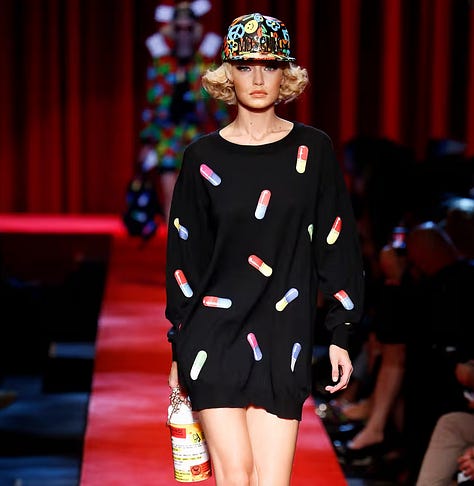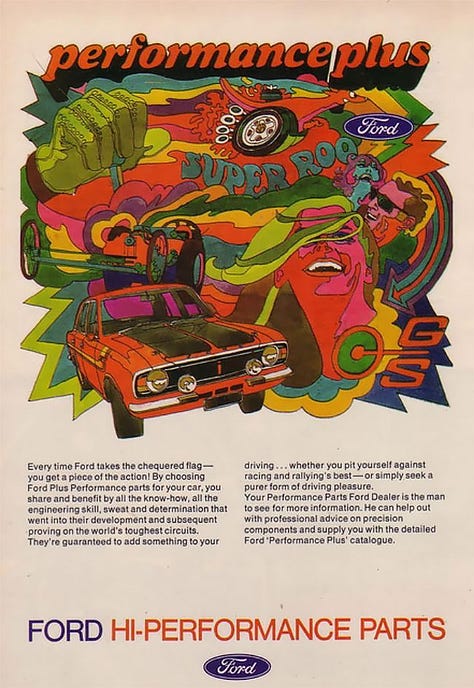Why don't brands do drugs?
Will 2025 be the year a mainstream brand features recreational drug use?
This post is a Trump take you probably didn’t see coming. But stay with me. Last week I did a talk at the Brands And Culture festival in London’s Ministry of Sound. The title was Last Night a DJ Saved My Loaf, it was about raving and farming and included a lot of references to drugs. In today’s newsletter I’m going to have a look at how brands talk about drugs and why this may increase in the future. TL:DR, shit’s going crazy but advertising has not kept up, it should.
A little bit on the talk. I’m a fractional CD for a company called WILDFARMED here in London. Wildfarmed was set up by a DJ. Andy Cato, one half of the band, Groove Armada. I’ll spare you the long version - the deck for the talk is here - but Andy started farming 15 years ago and after many many painful fails he finally figured out a way to grow regen wheat. His farm was awarded the most innovative farm in the whole of France. He was knighted by the French govt for services to agriculture. Even more impressive, he was an English bloke selling bread to Frenchies.
He set up the business with co-founders George Lamb and Edd Lees after meeting George in a night club in Ibiza. Andy still DJ’s to pay for tractors. With my creative partner, Flo Heiss, I have been working on the brand for about four years now. From day one we all had the idea that the Regen Agriculture movement was not dissimilar to kids dancing in fields at the dawn of the acid house (rave - but I hate that word) movement in the late 80’s early 90’s. Kids danced in fields as a protest to authority, individualism and Thatcherism. They were powered by more than pills, they were powered by hope. The same is true for regen ag. There is hope that growing food this way can solve many of our climate problems.
With this in mind we have always treated every piece of creative as an invite to a party. A rave, if you must. We use psychedelic imagery. Like this ad we did for our Waitrose launch.
We once did a concept with a mini bag of flour that looked like coke and presented an ad with the headline: ‘Our founders may have taken drugs but our fields are clean’.
Those ads didn’t run. Obviously. But why not?
Recreational drug use is a huge global cultural phenomenon but no mainstream brands go near it. Fashion brands are big on druggy vibes. I have an Edwin t-shirt that is a screen print of a mushroom field guide. And a running tee that says LSD - Long Steady Distance. I just finished Tricker’s Cabin, the excellent book about Online Ceramics, that is chocka with Grateful Dead and drug references. Alexander Wang did a whole collection based on cannabis leaves and so on.
Moschino ran a campaign that took it to another level. With pills rather than leaves. That campaign got so much press they had to take it down. With fashion brands it sometimes feels that the goal is not to sell clothes but to freak out the middle ground. For the lols. Perhaps another goal is to achieve notoriety to such an extent that you have to remove the campaign.



Mainstream brands have famously used druggy imagery. Coke, Pepsi, VW, Ford and many others co-opted counter-culture, hippies and acid in the 70’s. The famous open happiness work looks like someone is doing acid. Ben & Jerry’s is a product based on people with the munchies. This was all a vibe check rather than an explicit admission.



Back in the 90’s when we had an explosion of drug taking here in the UK there was one product that was inextricably linked to the culture; Lucozade. Originally marketed by GSK as something to take when you were recovering from being ill, it soon became the energy drink of choice for people who wanted to dance all night. Rave culture used the imagery, Adamski put out a record called NRG, but GSK actively distanced itself from the culture as seen in the letter below.
If, like me, you often wonder what’s really going on in a marketing exec’s mind, this letter that Ears To The House unearthed is a rare and brilliant glimpse into that world.


Of course five years later GSK released new varieties of Lucozade called Solstis and NRG to directly appeal to ravers but they were clumsy inauthentic attempts. That ship sailed and was promptly torpedoed by Red Bull.
A while back it was seen as potentially threatening to Obama’s political career that he admitted to using cocaine. Bill Clinton had to say he didn’t inhale. Most politicians read off the same script. ‘I tried it in college but I didn’t really like it’, or the more manly version, ‘It had no effect on me!’ The only politician that had the guts to tell the truth was Mike Bloomberg he said, ‘You bet I did. And I enjoyed it’. In the UK I personally wouldn’t trust someone that wasn’t taking pills and dancing in the fields to acid house when they were young. ‘Sir Kier, were you dancing in the fields off your nut on Ecstacy? If not, why not!?”
Now we have Trump, Elon, RFK Boris, who have ripped up the rules. It’s safe to say any pics of them doing drugs would have had zero negative effect in the elections.
Maybe they would have even helped? There will be a whole industry of content on why young men voted for Trump. Scott Galloway feels it’s because they thought Democrats talked down to them. BTW, left leaning, Galloway frequently talks about his ketamine use with no effect on his podcast ratings and speaking gigs. If he’s not getting cancelled why would a brand?
Back to the young men. My friend Jonathan, the CMO for Binance, thinks there were enough crypto bros that simply wanted bitcoin to go up and couldn’t care less about anything else so voted with their wallets. Binance, just one crypto exchange, has 60m users. If even a small percentage of the bros voted that way that’s enough to move the needle.
Take a look at crypto ads to see what kind of vibes these guys are into. It’s quick, brash, meme content. Lasers and cats and other things you like to look at while stoned. Or just weird shit like the Coinbase superbowl ad or the latest Gemini posters. These are lols adz, stoner content, not what you might call ‘proper ads’. Social films are created in AI programs and pumped out algorithmically. I remember when I first joined JWT as Chief Creative Innovation Officer (God I hate that title) back in 2012. We were having a discussion about how Crispin Porter were making ads for our shared client, Microsoft. Crispin were producing quick hits in 3-4 weeks. One of our ECD’s made the comment that this was not real advertising and that if Microsoft wanted that kind of drek (as opposed to the what - art? That we were taking six months to produce!?) they were welcome. We lost Microsoft a few weeks later.
Another friend who has a 20 year old son said that all his mates are using Cocaine. Or Ketamine. Elon is bang into Special K and anything else - all on record. And with RFK, who said ‘I’m no church boy’, when accused of sexual misconduct, running medical policy it’s fair to say that change is going to accelerate. The handbrake is not so much as off but has been ripped off and tossed blindly into the traffic behind, causing a pile-up.
But will any mainstream brands go along with this vibe? I did some research, asked my media mafia, and it still seems that no brands want to go there. There are adjacent druggy businesses like Happy Tuesdays, a supplement business for people that get wasted on the weekend. Happy Tuesdays have a cool vibe but even they are too scared to be explicit. It’s all done with a nod and a wink.



There are brands like Nutter Butter that produce work that looks like it came from people on drugs that the industry seems to love. The McDonalds Christmas ad (Christmas ads are the UK’s superbowl ads in terms of budget and scrutiny) is a couple driving down a suburban street where the Christmas lights come alive, rather like if you were off your head in a club. The film is set to Benny Benassi’s Satisfaction, which is an awful cheesy rave tune, but it’s a long way from ‘Chestnuts roasting on an open fire’. It will stand out because it’s different. Stoners will Uber McNuggets.
We are at a time where media and attitudes are being turned on their heads. The old norms don’t work any more. Long held assumptions don’t fly. But brands and agencies are not keeping pace. Someone, a big brand, will find the right tone around drug use.
Many of the kids that grew up doing drugs are now parents with purchasing power, who to this day still dabble. To be clear, I’m not recommending McDonalds start running ads about injecting heroin but there is an opportunity to show psychedelics, marijuana, ecstasy and other low risk drugs in a way that fits the reality of modern culture. It will work. There will be an outpouring of customers that say, ‘Finally a brand that gets it, that gets me, that’s not afraid to admit that we like to indulge every now and then’.
If they get that vibe right, it will be huge.
Kind of like Trump.







